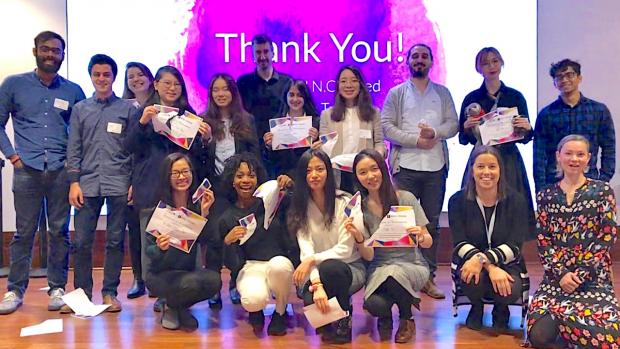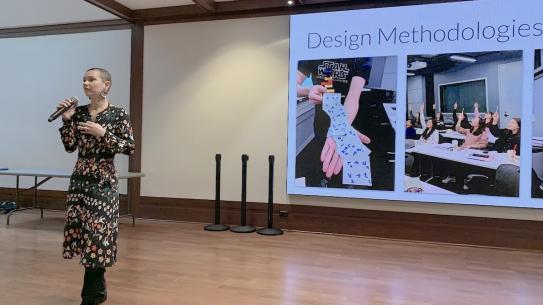United we solve
NYU Tandon partners with UNICEF to launch an impactful new course

Student participants in the class, UN-CHAINED: Assessing Emerging Technologies for Social Good, presented their work at a showcase held at UNICEF.
A decade ago, when the United Nations Children's Fund (more commonly known as UNICEF) wanted to explore using open-source hardware to collect real-time medical data from remote health clinics, Benedetta Piantella — now an industry assistant professor in Tandon’s Department of Technology, Culture, and Society — pitched in on prototypes that were field tested in Uganda. The project introduced her to UNICEF’s Christopher Fabian, who was spearheading the organization’s Innovation Team, which is aimed at enabling students to design solutions to the problems facing the world’s children — challenges exacerbated by the widening gulf between rich and poor, rapid urbanization, and climate change, among other factors.
Upon Piantella’s arrival at Tandon, she realized that such a challenge would be of great interest to her talented pool of Integrated Digital Media students, and a new course offering was born.
“Chris and I have learned from years of teaching socially focused courses that it is hard for students to be able to research, identify a specific problem, and propose a solution in just 14 weeks,” Piantella explains, “so we decided to anchor the class on one specific emerging technology, and we chose blockchain, since UNICEF has been delving into how that can be used in the social-impact space.” Christina Lomazzo, the UNICEF Innovation blockchain lead, co-taught the course with Piantella and Fabian.
Blockchain, often thought about merely in terms of cryptocurrency like Bitcoin, is in reality a sophisticated shared ledger, somewhat like a Google Sheet, which multiple people can curate in real time, and it can function as a social clearinghouse for peer-to-peer transactions of all kinds. As such, the technology can do far more than drive cryptocurrency; it could empower ambitious programs addressing climate change, for example, or the nearly two billion unbanked people with no access to loans.

Piantella’s students worked in groups to learn about blockchain and prototype ways to use it to address societal issues of their choosing. Among their ideas:
- Helping internet users foil online platforms that track and monetize data by adding “noise” in the form of false, random searches. (Its creators point out that an individual’s data is worth an estimated $3,000 per year, not a penny of which that individual is likely to see.)
- Bridging the digital divide in education by using a blockchain-enabled monitoring platform that would hold internet service providers accountable for delivering adequate bandwidth to underserved schools.
- Fighting sexual harassment by establishing a blockchain-enabled prevention and reporting system.
- Enabling better buying choices by creating a platform that lets users search for goods based on factors like fair trade and employment practices.
- Borrowing an idea from the Truepic video and photo verification platform, one team proposed a platform on which amateur photographers could upload photos of a specific event in exchange for tokens — in a sense, crowdsourcing enough information for verification purposes.
At the end of the course, the teams presented their work at UNICEF Headquarters, earning plaudits for their ingenuity and vision and earning a Certificate of Participation, uploaded onto the blockchain as a permanent record of their efforts.
“Overall, this was a gratifying and successful experience for all involved, and I’m looking forward to evolving the course further,” Piantella says. “We hope to develop online materials that anyone can use, and future editions might focus on other emerging technologies, like drones or virtual reality.”




